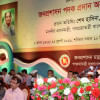Can Bangladesh hit development goals with scanty R&D?

Bangladesh's economy has been growing at a striking rate in the last one decade on the back of low-paid workers in the manufacturing and service sectors but innovation has played insignificant role behind the development journey.
The main factor for the lack of innovation has been scanty investment, both public and private, although investments in research and development (R&D) are believed to be important keys to future prosperity.
And experts warn that if the lower investment trend lingers, economic growth may be stuck at a certain level.
In Bangladesh, the overall R&D investments stood at 0.03 percent of gross domestic product (GDP) in 2022-23, according to data of the planning commission.
It was 0.54 percent in Vietnam, 0.70 percent in India, and 2.55 percent in China, World Bank data showed.
"Investment in R&D is essential as Bangladesh is steadily growing and is going to face challenges stemming from the fourth industrial revolution," said KAS Murshid, a noted economist.
A former director-general of the Bangladesh Institute of Development Studies, Murshid urged the government to place the highest priority on R&D, allocate funds accordingly and ensure their proper utilisation.
"A strong political will and understanding its importance is necessary."
Murshid points out that Bangladesh is bringing technologies and solutions from external sources and is adopting them. Sometimes, local people struggle to adopt them.
This forces many firms to hire experts from abroad to adopt new technologies and processes, which results in a spike in outward remittance from Bangladesh, he said.
"We need to innovate the technologies that are suitable for us."
In the era of the fourth industrial revolution, artificial intelligence (AI), deemed as the most important technological development in recent times, is expected to contribute to the economy and generate millions of jobs in new areas globally. At the same time, AI is believed to be taking away millions of traditional jobs.
"So, Bangladesh should prepare to adopt it and find out how we can make the most of it," Murshid said.
Today, Bangladesh is not a small economy – the nation is set to become a trillion-dollar economy in less than two decades, doubling from nearly $450 billion now.
The country aims to become an upper-middle-income country by 2031 and a developed nation by 2041.
"So, we should focus on R&D like other countries did," Murshid said.
A number of analysts have called for following in the footsteps of other countries that have built their economies, created wealth and raised the living standards of their people through innovation. One of the countries that stand out in the arena is China.
The country was struggling even in the 1980s with half of its population being poor and the economy was growing at a slower pace.
After the opening up of the economy in 1979, the Chinese government started to invest massively in R&D in order to make the economic growth sustainable. It also invited foreign investors.
The big investment in R&D and its hard-working population made China "the factory of the world" and put the economy on a higher growth trajectory.
China's expenditure on R&D reached $456 billion in 2022, up 10.4 percent year-on-year, according to the country's National Bureau of Statistics. Currently, China is the largest spender in the world in agricultural R&D.
The country leads globally in the areas of innovation, technology and adoption. It is particularly true in agriculture, manufacturing and outsourcing.
Today, China is the second-largest economy in the world.
According to Murshid, the agricultural sector of Bangladesh has seen some innovation over the years and most of them came through the Bangladesh Rice Research Institute.
"But there is more scope to carry out research in other sectors as well. But the government is not providing adequate funds and it has no clear plan for it."
The first time the government allocated any funds aimed at R&D was in the fiscal year of 2019-20 when it set aside Tk 50 crore, clearly highlighting the lack of focus on the side of the authorities in the previous years.
The government has made a special allocation of Tk 100 crore for research, innovation and development for the current fiscal year of 2023-24.
The private sector is not doing much as well.
According to the University Grants Commission of Bangladesh, 125 universities in the country spent close to Tk 153 crore on research in 2020, which was less than 1 percent of their combined annual budget.
The outlay aimed at research activities at all universities in the country is around one percent of their collective budget.
Khondaker Golam Moazzem, research director of the Centre for Policy Dialogue, a think-tank, says almost all developed countries focused on R&D and STEM (Science, Technology, Engineering, and Mathematics)-based education when their economy was taking off with a view to raising productivity.
"From that sense, Bangladesh is lagging far behind although the economy has been growing at a stellar pace for the past one decade."
In Bangladesh, the government seems to be pleased just by elevating the primary school enrollment rate to 100 percent. Similarly, companies are running their operations by adopting technologies and solutions from global sources instead of going for innovation, he said.
"As a result, value-addition of firms is low and the income of per unit exported item is also minimum."
The success of the country's largest export-earning garment sector, which has turned Bangladesh into the second-largest supplier globally, also hinged upon shipping low-priced clothing items using low-cost labour.
The remittance, another lifeline of the economy, also grew on the basis of the toils of unskilled workers. So, funds transferred by the migrant Bangladeshis have not gone up as expected.
For example, more than 11.35 lakh Bangladeshis left the country for jobs abroad last year. But remittance flow through official channels dropped 6.65 percent to $21.28 billion in 2022, data from the Bureau of Manpower, Employment and Training and the Bangladesh Bank showed.
Moazzem says a positive side is that the government has kept some funds in the national budget in the last few years. Most of the funds have been used in knowledge generation-based activities.
He, however, adds that some of the projects are not related to R&D.
"Our R&D budget should be used in innovating products, services and technologies that are commercially viable. The allocation needs to be increased and the government should pay heed to it."
The economist also urged the private sector to come forward to invest in R&D and recommended the government encourage entrepreneurs to do so by way of giving incentives, cutting taxes, and offering low-cost loans.
Moazzem thinks internationally renowned companies from other countries should be invited to invest in setting up R&D centres.
He, however, points out that R&D activities will not be encouraged until the government removes barriers related to intellectual property laws.
"This is because when a company innovates something, the rights linked to the innovation should be protected. However, the existing law is not protecting innovators properly."
Mahmudul Hasan Sohag, an entrepreneur, says globally, private companies mainly fund research activities whereas most of the firms in Bangladesh have no long-term vision to invest in R&D.
He says most of the investments behind R&D generally fail and only a few pay back, so local companies have no patience to go for the primary spending.
"Our companies have mainly the trading mentality, so there is little technology and product innovation in the country."
According to the co-founder of Rokomari.com, an e-commerce platform, the private sector may say that there are not enough researchers in Bangladesh, while universities may argue there are not enough fund providers.
"So, we need some crazy companies to bring a breakthrough and set an example."

 For all latest news, follow The Daily Star's Google News channel.
For all latest news, follow The Daily Star's Google News channel. 







Comments